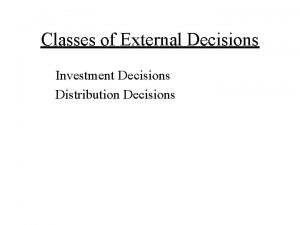Environment of Finance The financial decisions of a



































- Slides: 35

Environment of Finance • The financial decisions of a firm are influenced by the legal form of its organization, the regulatory framework governing it, the tax laws applicable to it, and the features of the financial system in which it operates. Examples: • A private limited company cannot raise equity capital by issuing shares to the general public. • A company in which foreign shareholding is 100% may not be allowed to undertake certain activities. • Tax rate for a cooperative society is lower than that of a public limited company • Financial institutions go by a debt-equity norm of 1: 1

1. Forms of business organisation Sole proprietorship – is a business owned by a single person. Legally, the owner and company have same status. Owner realizes all the profits, bears all the losses and incurs all the liabilities of the business. Advantages: 1. Can be set up easily (no formal requirement of incorporation) 2. Subject to few government regulations. 3. No firm tax rate. Limitations: 1. Life is limited to life of the owner. 2. Personal liability is unlimited. 3. Ability to raise funds is severally constrained.

Forms of business organization 2. Partnership – business owned by 2 or more persons. Partners bear the risks and reap the rewards of the business. Comes into existence with the execution of a partnership deed. Governed by the Indian Partnership Act of 1932. Advantages: 1. Can be set up with relative ease. 2. Can benefit from expertise and experience of partners. 3. Relatively free from government regulations. Limitations: 1. Life is limited to death or withdrawal of any of the partners. 2. Personal conflict among the partners is a potential threat. 3. Personal liability of the partners is unlimited. 4. Ability to raise funds is limited.

Forms of business organization 3. Cooperative Society – a society which has as its objective the promotion of economic interests of its members in accordance with cooperative principles. Features: 1. No limit on maximum members, but a minimum of 10 members are required. 2. Registered under the Registrar of Cooperative Societies. 3. Management is vested in the managing committee elected by members on the principle of “one member, one vote”. 4. Dividend paid is subject to a ceiling of 9%. Surplus left after the dividend payment is distributed in the form of bonus.

Forms of business organization • 3. Cooperative Society Advantages: 1. Can be formed easily. 2. Liability of members is limited. 3. Grants and financial assistance is provided by the government. Disadvantages: 1. Members have no incentive to provide capital. 2. Often, influential members exploit the cooperative society for personal gains.


Joint Stock Company – Private and Public Company Joint stock company is a form of organization which is capable of mobilizing larger amount of capital with provision of limited liability for owners and affording professional management to conduct its business.

Nature of a Company • Company means a voluntary association of persons united for a common objective. Important facts: q Association has too many members that it is not to be called partnership firm. q Every member of the association has the right to transfer his interest with the consent of the other members. q It has separate legal entity. q The company is manage by a board of directors elected by the shareholders. q Governed by Indian Companies Act, 1956. q Law creates it and law alone can dissolve it.

Definition of a company “A company is an artificial person, created by law having a separate entity with a perpetual succession & a common seal. ”

Characteristics of a company • • Artificial person Voluntary associations of persons Separate legal entity Has perpetual succession Every shareholder has limited liability It acts through its agents called Directors Common seal acts as the official signature of the company.

Private Company - Features • Can be formed by two persons subscribing to its share capital • Number of shareholders cannot exceed 50 • Public cannot subscribe to its capital

Procedure of registration of Joint stock company • Promoter is a person who conceives & develops an idea of starting a company • Application is filed with the Registrar of the companies.

Documents accompanying the application 1. • • • Memorandum of association It lays down: Name of the company Name of the state in which its registered office is situated The objective of the company A statement whether the liability of its shareholder is limited The amount of capital with which the company is registered together with its division into shares. Subscription clause: Mo. A must be signed by 7 members in case of public limited company and by 2 members in case of private company.

Documents accompanying the application 2. Articles of association: bye-laws or regulations to govern the internal affairs of the company, for eg. , transfer of shares, forfeiture of shares, qualification, powers and duties of directors, etc. 3. 4. Consent of directors Statutory declarations: by an advocate/company secretary/CA that all requirements of the Companies Act have been fulfilled. If the Registrar is satisfied with the documents, he issues a certificate called the certificate of incorporation. Upon its issue the company is born.

Prospectus • A private company can commences business immediately after obtaining the certificate of incorporation but for a public company to commence business, it is necessary to receive certificate to begin business from the registrar of companies. For this purpose, it is necessary for the company to issue prospectus or statement in lieu of prospectus. (Schedule III) • According to Sec 2(36) of the Act “prospectus means an invitation to the public for the subscription of its shares or debentures. ” it must be dated and signed by all the directors and a copy must be filed with the Registrar on or before the date of publication thereof.


Types of capital • Each company has 2 types of capital 1. Share capital 2. Loan capital

Meaning of Share The capital of a company is divided into a number of equal parts. Each part is called a Share. The Companies Act of 1956 defines a share as “a share in the share capital of the company” The persons who contribute money through shares are known as ‘shareholders’. The certificate stating the number of shares a shareholder holds is called a share certificate.

• 1. 2. 3. Types of Shares Preference Share Cumulative Preference Share Non-cumulative Preference Share Participating Preference Share – in this case surplus profits are also distributed amongst the preference shareholders. 4. Non-participating Preference Share 5. Redeemable Preference Share 6. Convertible and non-convertible preference shares – a convertible preference share can be converted into equity shares. • Equity Share

Share capital The memorandum of associations must state the amount of capital with which the company is desired to be registered & the number of shares into which it is to be divided. Total capital of company is divided into shares, therefore, it is called share capital.

Kinds of Share Capital • Authorized Capital – given in the Mo. A, this is the maximum amount with which the company is registered and which it is authorized to raise from the public by issue of shares. Also called registered or nominal or authorized capital. • Issued Capital – the portion of authorized capital which is offered to the public for subscription is called issued capital and the remaining portion not yet offered to the public for subscription is called unissued capital. • Subscribed Capital – the portion of issued capital which has been subscribed for by the public, I. e. , applied for and allotted by the company. The balance os issued capital not subscribed for by the public is called the unsubscribed capital.

Kinds of Share Capital • Called up Capital – the portion of the subscribed capital which the shareholders are called upon to pay is termed as called up capital of the company. The balance of subscribed capital which has not been called up represents uncalled capital. • Paid up Capital – the amount of called up capital which has been actually paid by the shareholders is called as paid up capital and the amounts yet due from the shareholders are called calls in arrears. • Reserve Capital – sometimes a company by means off special resolution decides that certain its existence and it would be available as an additional security to its creditors in the event of liquidation. Such a portion of uncalled capital is termed as “reserve capital”.

Liabilities Share capital: Authorised capital: 2, 000 equity shares of Rs. 10 each Issued capital: 1, 000 equity shares of Rs. 10 each Subscribed capital: 80, 000 equity shares of Rs. 10 each Called up and paid up capital: 80, 000 equity shares of Rs. 8 per share Rs. 20, 000 10, 000 8, 000 6, 40, 000 Assets Rs.

Principal sources of Capital Reserve 1. 2. 3. 4. 5. Profit on sale of fixed asset Profit on revaluation of assets & liabilities Profit on forfeiture & re-issue of forfeited shares Profit on redemption of debentures at a discount Profit earned by a company prior to its incorporation Capital reserve is shown in the liabilities side of balance sheet under the head “reserves and surplus”

Procedure for issue of Shares 1. Issue of prospectus – to attract the public for investment. 2. To receive Applications – name of the schedule bank, dates of opening and closing, application form, etc. 3. Allotment of Shares – only when minimum subscription is received (90% of the issued amount) 4. To make Calls on Shares – the first and second installments are for application and allotment

Utilization of Securities Premium Amount The premium amount of the shares issued is credited to a separate account called ‘Securities Premium Account’ It can be used for: • To issue fully paid up bonus shares to the shareholders • To write off preliminary expenses of the company • To write off the expenses or commission paid, or discount allowed on issue of the shares or debentures of the company • To pay premium on the redemption of preference shares or debentures of the company.

Issue of Shares at Discount Shares issued at an amount less than the face value of the share. Conditions for Issue of Shares at Discount: • The articles of association of the company must provide for the issue of shares at a discount. • The shares are of a class which has already been issued. • The issue of shares at a discount is authorized by an ordinary resolution passed by the company at its general meeting & sanctioned by the Company law board. • The rate of discount must not exceed 10% of the nominal value of share. If its >10%, its compulsory to get permission from Company Law Board. • At least 1 year must have elapsed since the company was entitled to commence the business. • The shares are issued within 2 months from the date of receiving sanction for the same from Company Law Board.

Calls in Arrears Sometimes, some of the shareholders may fail to pay the amount due from them on allotment or on call. The amount remaining unpaid on allotment or on calls is called callsin-arrears. or Any installment amount whether allotment money or call money, called but the company, but not paid by the shareholder.

Forfeiture of Shares If a shareholder fails to pay the allotment money or/and call money on his shares as called upon by the directors, his shares may be forfeited by the directors, if they are so authorized by the Articles of Association.

Over-subscription of shares When application for more shares are received then the number of shares offered to the public is said to be the case of Over-Subscription. Alternatives to deal with such situation are: • Full allotment to some applicants while rejecting the others. • To make pro-rata allotment. • Combination of the above two.

Regulatory framework • Industrial policy – Industrial Development (and Regulation) Act, FEMA, Incentives for export oriented units, incentives for small sector, incentives for high priority industries. • Companies Act 1956 • SEBI Act 1992 – after repeal of Capital Issues Control Act. • Taxes – corporate income tax (30% for domestic, 48% foreign companies), depreciation, interest expense versus dividend payment, unabsorbed business loss (can be claimed over next 8 years’ income), exemptions and deductions, minimum alternate tax (7. 5% of book profit), advance tax, capital gains, indirect taxes (excise duties, sales tax, customs duty)

Financial system • Financial institutions • Supplier of funds – individuals, businesses, governments • Demanders of funds – same • Financial markets (money markets and capital markets) To convert savings into investments.

Forms of Balance sheet • Vertical • Horizontal

The Sarbanes – Oxley Act of 2002 (SOX) An act aimed at eliminating corporate disclosure and conflict of interest problems. Contains provisions about corporate financial disclosures and the relationships among corporations, analysts, auditors, attorneys, directors, officers and shareholders.

SOX did the following: • Established an oversight board to monitor the accounting industry; • Tightened audit regulations and controls; • Toughened penalties against executives who commit corporate fraud; • Strengthened accounting disclosure requirements and ethical guidelines for corporate officers; • Established corporate board structure and membership guidelines; • Established guidelines with regard to analyst conflicts of interest; • Mandated instant disclosure of stock sales by corporate executives; and • Increased securities regulation authority and budgets for auditors and investigators.
 Poster making meaning
Poster making meaning Financial environment in business environment
Financial environment in business environment Screening decisions and preference decisions
Screening decisions and preference decisions Chapter 4 financial decisions and planning
Chapter 4 financial decisions and planning Chapter 4 financial decisions and planning
Chapter 4 financial decisions and planning Chapter 4 financial decisions and planning
Chapter 4 financial decisions and planning Chapter 4 financial decisions and planning
Chapter 4 financial decisions and planning Chapter 4 financial decisions and planning
Chapter 4 financial decisions and planning The role and environment of managerial finance
The role and environment of managerial finance Pilbeam k. finance and financial markets
Pilbeam k. finance and financial markets Finance and financial markets keith pilbeam
Finance and financial markets keith pilbeam Finance for non-financial managers ppt
Finance for non-financial managers ppt Financial services marketing environment
Financial services marketing environment The business tax and financial environment
The business tax and financial environment International monetary and financial environment
International monetary and financial environment International financial environment
International financial environment International financial environment
International financial environment The financial market environment
The financial market environment Hình ảnh bộ gõ cơ thể búng tay
Hình ảnh bộ gõ cơ thể búng tay Lp html
Lp html Bổ thể
Bổ thể Tỉ lệ cơ thể trẻ em
Tỉ lệ cơ thể trẻ em Gấu đi như thế nào
Gấu đi như thế nào Glasgow thang điểm
Glasgow thang điểm Alleluia hat len nguoi oi
Alleluia hat len nguoi oi Môn thể thao bắt đầu bằng chữ f
Môn thể thao bắt đầu bằng chữ f Thế nào là hệ số cao nhất
Thế nào là hệ số cao nhất Các châu lục và đại dương trên thế giới
Các châu lục và đại dương trên thế giới Công thức tính độ biến thiên đông lượng
Công thức tính độ biến thiên đông lượng Trời xanh đây là của chúng ta thể thơ
Trời xanh đây là của chúng ta thể thơ Mật thư anh em như thể tay chân
Mật thư anh em như thể tay chân Phép trừ bù
Phép trừ bù Phản ứng thế ankan
Phản ứng thế ankan Các châu lục và đại dương trên thế giới
Các châu lục và đại dương trên thế giới Thơ thất ngôn tứ tuyệt đường luật
Thơ thất ngôn tứ tuyệt đường luật Quá trình desamine hóa có thể tạo ra
Quá trình desamine hóa có thể tạo ra



























































